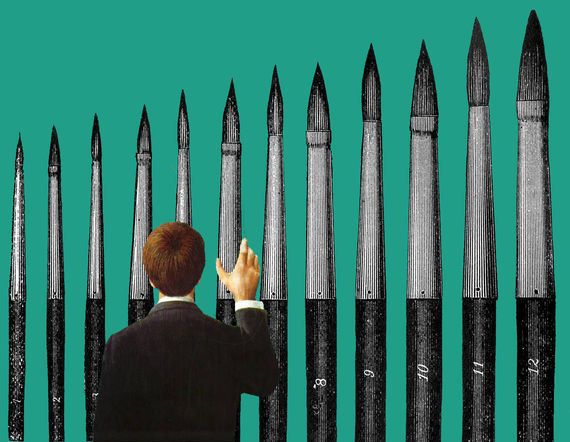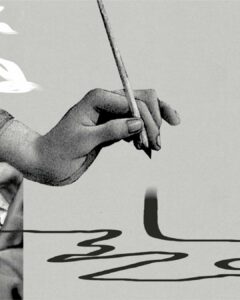

“As an art student, you learn quickly that the material necessary to start painting is expensive and a 16-17 year old does not have the money for it. This is how the career of a young painter kicks off,” explains Yulia Mayfair, a painter who currently works as a waitress. And though she does not remember a time when she was not painting, even as an art student she knew she would never make a living with her art.
Sculptor Edgar Hovhannisyan has also stopped thinking of art as a profession. Going to the army meant the process of self-improvement as an artist had to be halted. He still sculpts when he has spare time from his job as a dental technician-ceramist.
Stories of artists giving up on art as a profession might be as old as times unknown, the reasons can be many of course but the issue of making a living as a young artist is definitely a classic.
Our unofficial inquiry into the few art galleries in Yerevan showed that preference is usually given to the older, more experienced generation of artists and the works of the independence generation proportionally have poorer representation. Most of the galleries we asked did not have any artwork by the independence generation. Only a few said that about 25 percent of the work they represent is by young artists.
While getting a slot at commercial galleries is not an easy task, younger artists seem to have found an alternative space in Armenia on the walls of cafes and bookstores. Hasmik Khachatryan, the owner and director of Canvas, a cafe-gallery in Yerevan, says the space was initially intended to only represent the works of young artists, they sometimes even exhibit artwork by students.
ArtBridge is another example, a bookstore-cafe-gallery, ArtBridge has always had exhibits on its walls that are also for sale, regardless if they are by aspiring or already accomplished artists. Owner and manager Shakeh Havan describes the choice of art as a “democratic process.” The artist calls and they put it in the queue and when the time comes, the work is exhibited. As for the difference between being an artist and having some other profession, Mrs. Havan notes, “If a translator fails in their task, he/she can be criticized and the mistake can be corrected, but painting is an individual, subjective process and there is no room for corrections in a completed canvas.”
While places like Canvas and ArtBridge are attempting to meet young artists halfway, curators point to more fundamental problems. Director of the Institute for Contemporary Art, curator and art critic Nazareth Karoyan says the problem is not one that only affects young artists, it is in the lack of an art industry, especially the lack of galleries.
“In the Soviet Union, the artist had ideological issues to deal with and could not self-express freely,” explains Karoyan. “Today those ideological issues are a non-problem but now artists have the economics of the industry to deal with and this impacts the creative process equally.”
Curator Teresa Davtyan has put special emphasis on presenting work by young artists in the latest exhibition she curated, trying to bring new artists to light. “I try to give them an opportunity to be exhibited alongside the older generation but I have to admit that they are quite ambitious, they do not know the work of their predecessors, the older generation is not acquainted with the work of the artists that came after them either,” Davtyan says. “I try to bring them together through my exhibitions, give them an opportunity to get to know one another. The field in narrow, the problems are many but finding solutions is on all of us, no one will do it for us.”
Karoyan says that many of the issues facing contemporary artists derive from a lack of know-how, abilities, language skills, and also lack of experience. For the past 15 years he has been invested in developing the art of curatorship in Armenia with the belief the artist will flourish with the reinforcement of the institute of the art critique, that the culture of collaboration will benefit both the artist and the curator, bring about noticable change in the art industry.
Tereza also believes there is something to be gained from the artist-curator collaboration. Another option is to organize more exhibitions, and there is no need to be too picky in the choice of artwork. There is something to be said about exhibiting that which is available. Tereza believes it is important for young artists to be in touch with reality, to have a finger on the pulse of the times they are living in. Being open to possible collaborations, assuring disagreements can be delicately ironed out in a manner that benefits the artist.
Karoyan points out that the government too can have its role in developing the art industry. If favorable conditions are in place, individuals can be encouraged to invest in the art industry integrating more artists and presenting more to the pubic. “To deal with the new generation, means to also be a luminary, to be able to see potential,” says Karoyan.
More than complaints about the lack of spaces, affordability of supplies, and similar issues, a change in attitude is what all artists and curators wish for; an issue that is not dependant on financial capacity. “Art has to become a part of education starting at an early age and develop with the person throughout all the stages of her/his life,” says Edgar Hovhanesyan, who still hopes that one day, people will buy art for its worth and not as an accessory to furniture.

